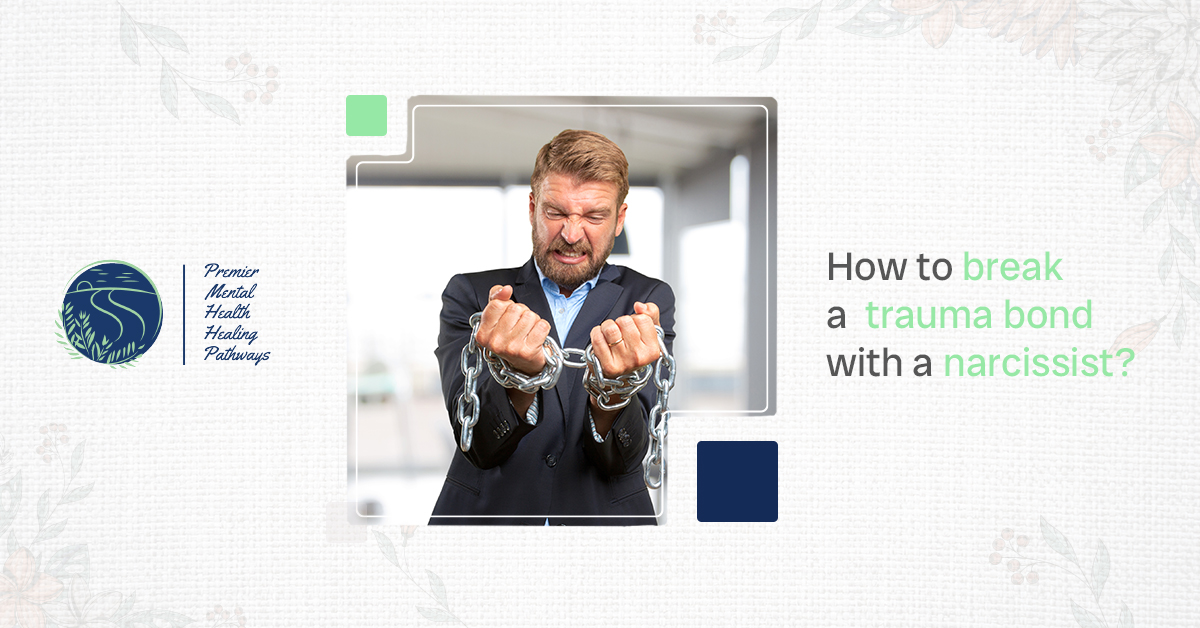Why is it so hard to leave a narcissist? It’s similar to fleeing a cyclone. Such relationships involve more than emotional abuse. They often create trauma bonds, making it hard to leave.
These bonds tie you to an abuser, trapping you in manipulation and mistreatment.
But if you’re wondering how to break a trauma bond with a narcissist, it is possible. It may come across as unthinkable, but regaining command of your life is doable.
At Premier Mental Health Healing Pathways, we get your struggle. We’re ready to help you take back control. Just Contact us for more information.
What is Trauma Bonding?
In simpler words, trauma bonding means victims and their abusers are emotionally tied. This happens in narcissistic relationships where the victims are trapped by fear, false love, and mind games.
This causes the victims to think they can’t live without the narcissists, even if it’s destructive, due to the deep mental impact. So, trauma bonding is all about harmful relationships and high emotional stakes.
Why Narcissists Create Trauma Bonds
People who are narcissistic love to control and manipulate. They switch between affection and emotional harm. It leaves their victims always unsure and needy. But this is on purpose.
It makes sure victims stay connected even when they’re hurting. Narcissists are hungry for power. Trauma bonds let them control victims completely.
They often use your fears and doubts against you. They convince you that you’re the issue. A never-ending cycle of emotional ups and downs deepens the bond. That makes it harder to escape it.
Signs You Are in a Trauma Bond with a Narcissist
Recognizing trauma bond signs is vital for breaking free. Here are key indicators:
- Continuous Guilt: You wrongly blame yourself for everything.
- Rationalizing Harmful Actions: You often defend the narcissist’s hurtful actions.
- Withdrawal: To dodge tension or judgment about your relationship, you shrink from friends or family.
- Emotional Reliance: Your sense of satisfaction or self-value is linked to the narcissist’s approval.
- Struggling to Escape: Despite realizing your relationship is unhealthy, exiting is hard.
Spotting these signs is the first step. It means facing the truth of your situation and getting ready to act.
Stages of Leaving a Narcissist
Denial: At first, a person might not know the harmfulness of the relationship or the nasty actions of the narcissist. They might downplay the bad parts or come up with explanations.
Anger: This is when feelings like annoyance, feeling tricked, and blame towards the narcissist swoop in. A person might even feel mad at themselves for sticking around too long.
Bargaining: Here, people might try to strike a deal or adjust things for their own good. They can promise to tweak their actions or mend the broken ties.
Depression: This is when the harsh truth hits about the relationship’s bad impact. Sadness, sorrow, and despair cloud judgment. This phase involves accepting the unrealized potential of the relations and its actual fallout.
Acceptance: The ending stage is when a person finally understands that breaking free is the best choice. This is when personal needs are acknowledged and healing begins.
How to Break a Trauma Bond with a Narcissist?
Breaking a trauma bond with a narcissist is tough. It requires breaking emotional dependencies and unhealthy ties. Here’s a simple step to help you.
- Acknowledge the Trauma Bond
Acknowledge that you’re in a trauma bond. This bond features emotional extremes, manipulation, and dependency on the narcissist for validation. Understanding this is key to breaking free.
- Educate Yourself About Narcissism
Discover the dynamics of narcissistic personality disorder and how it impacts bonds with others. Start by spotting a narcissist’s actions, like manipulation, excessive affection, and mental harm. Recognizing such actions will aid in identifying trends and shielding your feelings.
- Set Clear Boundaries
Set clear boundaries with the narcissist. Limit or stop contact. Avoid triggers. Don’t argue or engage in manipulation.
- Get Professional Support
Talk with a mental health expert trained in trauma and narcissistic mistreatment. Counseling can help you to handle feelings, reconstruct self-worth, and establish better relationships.
- Build a Support Network
Be with supportive friends and family for encouragement and perspective. A strong support system helps you stay grounded and confirms your decision to leave a toxic relationship.
- Focus on Self-Care
Take care of your body, heart, and mind. Follow your passions, be mindful, and stay healthy. These actions promote healing and growth, rebuilding you from the inside.
- Rebuild Your Identity
Find yourself beyond the relationship. Concentrate on your passions, beliefs, and ambitions, unaffected by the narcissist’s sway. Recreating your image is essential for progress and realizing self-value.
- Avoid Idealizing the Past
Don’t idealize your past relationship. Narcissists often seem perfect, making it tempting to go back. However, remember the pain and manipulation you faced. This will keep you focused on healing.
- Practice Forgiveness and Letting Go
Forgive yourself for mistakes or weaknesses in the relationship. Also, release any anger or resentment towards the narcissist. Holding onto these feelings can slow your healing and keep you tied to the past.
- Take It One Step at a Time
Breaking a trauma bond takes time. Take it easy, and realize that recovery happens step by step. Cheer for minor triumphs as you journey to a happier, more satisfying existence.
How to Leave a Narcissist When You Live Together?
Leaving a narcissist you live with is tough. Their manipulative and controlling behavior complicates things. Here are steps to help.
- First, create a clear plan. Include:
- Financial arrangements
- Housing options
- Legal considerations
- Keep plans secret. Get support from trusted friends, family, or a therapist.
- Set boundaries. Aim for emotional independence.
- If you can, consult a legal expert to understand your rights. This protects your interests.
- During the shift, minimize contact with the narcissist. Build a support network. This aids in recovery.
How Long Does a Trauma Bond Last?
The duration of trauma bonds varies by relationship type, trauma level, and healing ability. Typically, they last from months to years after the trauma.
Such bonds persist due to cycles of harm or manipulation, creating strong emotional ties. These ties are tough to break.
Often, trauma is mixed with brief positive experiences, making it harder to let go. The bond’s length and recovery depend on support, therapy, and personal strength.
With the right help and self-awareness, people can break these bonds and find healthier relationships.
Conclusion
To sum up, how to break the trauma bond with a narcissist? Breaking a narcissist requires bravery and self-awareness.
First, identify their harmful patterns. Then, cut emotional ties. Gradually, regain your independence. Healing starts once you’re free from their control.
Enjoy your new freedom. Continue your journey to self-discovery and peace. A better future lies ahead, away from manipulation.
FAQs
Can childhood trauma cause narcissism?
Yes, childhood trauma can cause narcissistic traits. They are a defense against emotional pain.
How to deal with a drug addict narcissist?
Draw clear lines for your security. Reach out to experts to tackle both self-centered actions and addiction. Keep your health in mind as you nudge them toward getting help.
What’s the reason behind narcissists use the silent treatment?
Narcissists, through silent treatment, aim to influence, dominate, and discipline their targets.
How to get out of a narcissistic relationship?
Set firm limits, and ask for backing from dependable buddies or a counselor. Shift your attention to your recovery, and slowly pull back from the relationship.






No comment